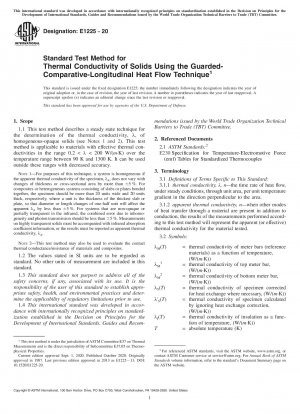ASTM E1225-20
Standard Test Method for Thermal Conductivity of Solids Using the Guarded-Comparative-Longitudinal Heat Flow Technique
- Standard No.
- ASTM E1225-20
- Release Date
- 2020
- Published By
- American Society for Testing and Materials (ASTM)
- Latest
- ASTM E1225-20
- Scope
- 1.1 This test method describes a steady state technique for the determination of the thermal conductivity, λ, of homogeneous-opaque solids (see Notes 1 and 2). This test method is applicable to materials with effective thermal conductivities in the range 0.2 < λ < 200 W/(m·K) over the temperature range between 90 K and 1300 K. It can be used outside these ranges with decreased accuracy. NOTE 1—For purposes of this technique, a system is homogeneous if the apparent thermal conductivity of the specimen, λA, does not vary with changes of thickness or cross-sectional area by more than 65 %. For composites or heterogeneous systems consisting of slabs or plates bonded together, the specimen should be more than 20 units wide and 20 units thick, respectively, where a unit is the thickness of the thickest slab or plate, so that diameter or length changes of one-half unit will affect the apparent λA by less than 65 %. For systems that are non-opaque or partially transparent in the infrared, the combined error due to inhomogeneity and photon transmission should be less than 65 %. Measurements on highly transparent solids must be accompanied with infrared absorption coefficient information, or the results must be reported as apparent thermal conductivity, λA. NOTE 2—This test method may also be used to evaluate the contact thermal conductance/resistance of materials and composites. 1.2 The values stated in SI units are to be regarded as standard. No other units of measurement are included in this standard. 1.3 This standard does not purport to address all of the safety concerns, if any, associated with its use. It is the responsibility of the user of this standard to establish appropriate safety, health, and environmental practices and determine the applicability of regulatory limitations prior to use. 1.4 This international standard was developed in accordance with internationally recognized principles on standardization established in the Decision on Principles for the Development of International Standards, Guides and Recommendations issued by the World Trade Organization Technical Barriers to Trade (TBT) Committee.
ASTM E1225-20 Referenced Document
- ASTM E230 Standard Specification and Temperature-Electromotive Force (EMF) Tables for Standardized Thermocouples
ASTM E1225-20 history
- 2020 ASTM E1225-20 Standard Test Method for Thermal Conductivity of Solids Using the Guarded-Comparative-Longitudinal Heat Flow Technique
- 2013 ASTM E1225-13 Standard Test Method for Thermal Conductivity of Solids Using the Guarded-Comparative-Longitudinal Heat Flow Technique
- 2009 ASTM E1225-09 Standard Test Method for Thermal Conductivity of Solids by Means of the Guarded-Comparative-Longitudinal Heat Flow Technique
- 2004 ASTM E1225-04 Standard Test Method for Thermal Conductivity of Solids by Means of the Guarded-Comparative-Longitudinal Heat Flow Technique
- 1999 ASTM E1225-99 Standard Test Method for Thermal Conductivity of Solids by Means of the Guarded-Comparative-Longitudinal Heat Flow Technique
